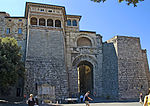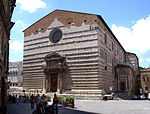San Michele Arcangelo, Perugia

San Michele Arcangelo, also known as Sant'Angelo, is a paleo-Christian temple in the city of Perugia in Umbria. The circular building dates to the 5th to 6th century, and incorporates corinthian capped columns from a prior pagan temple. It is dedicated to the Archangel Michael, whose churches were often located in elevated spots. The small round church is also often called Tempio or Tempietto, and is located in the neighborhood Borgo Sant'Angelo, near the ancient northern gate (Porta Sant'Angelo) of the city. The structure of the church has been altered across the centuries; in 1479, it was converted into a small fort. A major restoration occurred in 1948 that revealed ancient frescoes and sealed windows. The architecture is an early Romanesque with Byzantine influences in the chapel placement, but the circular temple is something seen in other ancient churches in central Italy, including the church of Sant'Ercolano and of San Giovanni Rotondo in Perugia. It recalls the church of Santo Stefano Rotondo (460-480) in Rome.
Excerpt from the Wikipedia article San Michele Arcangelo, Perugia (License: CC BY-SA 3.0, Authors, Images).San Michele Arcangelo, Perugia
Via del Tempio, Perugia Sant'Erminio
Geographical coordinates (GPS) Address External links Nearby Places Show on map
Geographical coordinates (GPS)
| Latitude | Longitude |
|---|---|
| N 43.12 ° | E 12.3853 ° |
Address
Chiesa di San Michele Arcangelo (Tempio di Sant'Angelo)
Via del Tempio
06122 Perugia, Sant'Erminio
Umbria, Italy
Open on Google Maps








